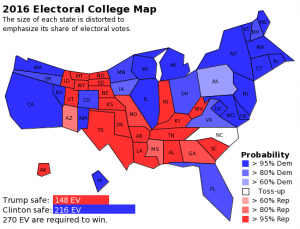Patrick Healy reports at The New York Times that “Bernie Sanders Is Expected to Endorse Hillary Clinton Next Week.”
“Is the Working Class Really Furious at the Upper Middle Class?” asks Kevin Drum at Mother Jones. ” wouldn’t be surprised if members of the lower middle class are more resentful of elites today than they were in the past. But I’m awfully tired of hearing this asserted endlessly based on nothing much at all. Throw me a bone, folks. Give me some real evidence that the working class is angrier than it’s ever been. Anything will do. Polls. Surveys. NSA wiretaps. Something—other than the fact that Donald Trump has a following among a group of Republican voters who have been mad at the eggheads forever and mad at Democrats ever since the Civil Rights Act was passed. What have you got?”
“My independence is pretty clearly demonstrated when I de-endorsed Donald Trump,” the Illinois Republican told a local radio station. “I felt Donald Trump was too bigoted and racist for the land of Lincoln.” – from Jordain Carney’s post, “GOP senator touts break from Trump” about Sen. Mark Kirk’s 180 degree flip-flop on Trump at The Hill. Political observers believe Democratic candidate Rep. Tammy Duckworth has an excellent chance to defeat Kirk in November.
Esther Yu-Hsi Lee reports that a “New Poll Reveals That Americans’ Anti-Immigrant Attitudes Are Fueled By Racism.” Lee notes “…According to the poll commissioned by Vox in partnership with Morning Consult, a nonpartisan media and technology company, American voters are worried about immigrants mostly because they have racialized fears of crime and terrorism…The poll, which looks at Americans’ views on immigrants from various countries, found that white Americans tend to have negative opinions about immigrants from non-European countries. They’re least positive about immigrants from the Middle East, and also hold negative views about immigrants from Latin America and Africa. At the same time, however, white Americans have a much more positive view of European immigrants and Asian immigrants.”
“Democrats Plan Early Attacks Tying G.O.P. Candidates to Trump” reports Alexander Biurns at The New York Times. Burns explains, “The attacks, set to air on cable television and online, are an unusually early effort to nationalize the battle for control of Congress. They target 10 incumbent Republican lawmakers in areas where Mr. Trump is expected to run poorly, including Denver, San Antonio and the Chicago suburbs…In one of two ads, the Democratic committee accuses Republicans of enabling a “bully” with “ideas that threaten our country’s security.”…“Republicans in Congress are just standing by him,” the ad says. “But shouldn’t they really be standing up to the bully?”
“Trump may be trailing in the polls,” writes Zachary Roth at NBC News, “and his cash-strapped campaign may be struggling to build a viable operation in key swing states. But the new wave of Republican-backed restrictions on voting — which look set to keep Democratic voters from the polls — could wind up being Trump’s ace in the hole if the race is close this fall. Tight voting laws also could boost the GOP in a host of House, Senate, governor, and state legislative races.
Greg Sargent sums it up succinctly at The Plum Line: “Trump’s con game is simple. He is trying to win over working class whites with anti-China, anti-free-trade bluster and a vow to crush the dark hordes who make them feel threatened culturally and economically, while simultaneously retaining just enough good will (via his other proposals) from GOP-aligned elites to remain the nominee and be competitive. This is not ideological heterodoxy. It’s a smorgasbord of policy ignorance and indifference, opportunism, making-it-up-on-the-fly, and of course, good old fashioned flim-flammery….Now, to be sure, Trump probably will win a sizable victory among working class whites. But it is also likely that he won’t be able to win among them by a large enough margin to offset countervailing demographic realities…”
Campaign for America’s Future’s Dave Johnson has more to say on this topic in his post, “Exposing Trump’s Trade Appeal to Working-Class Voters for What It Is” (reposted) at Alternet.
Also at Mother Jones, Patrick Caldwell rolls out the rationale for the play-it-safe Democratic running mate option: “He’s No One’s Idea of a Liberal Hero, But Tim Kaine Is a Natural Fit for Clinton: Behind the Virginia senator’s moderate reputation is a history of quiet progressive activism.”




